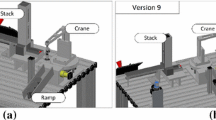Abstract
The majority of current feature-based modeling systems employ model history to store feature creation operations and re-execute them sequentially after each modification, which is called history-based modeling. Due to the static feature creation order, history-based modeling causes some problems during the reevaluation of the model, such as the evaluated model does not correspond to its specification, the operation can only refer to the boundary entities created by the previous operations, high computation cost, etc. In this research work, a new history-independent modeling approach is proposed. For the “remove feature” operation, only boundary faces originating from the feature being removed, and the intersecting features are modified for updating the resulting BRep model. For the “modify feature” operation, the feature being modified is first removed from the product model and then re-added with the new specifications, thus its creation step in the model history is changed. As a result, some of the problems caused by the static feature creation order are solved. During the reevaluation, the computation time is dependent solely on the execution of the feature and its intersecting features being edited. The computational complexity of the boundary evaluation using the proposed method for three representative models has been analyzed based on Open CASCADE. A case model was studied in a proof-of-concept prototype system to demonstrate the proposed modeling approach.
Similar content being viewed by others
References
Gomes AJP, Teixeira JCG (1991) Form feature modelling in a hybrid CSG/BRep scheme. Comput Graph 15(2):217–229
Wang YW, Wu JJ, Chen LP, Huang ZD (2005) Identity propagation method for tracing alterations of a topological entity in a history-based solid modeling system. Int J Adv Manuf Technol 27:305–312
Rao Nalluri SRP, Gurumoorthy B (1993) Knowledge-based gluing operators for feature-based modeling. Comput Ind 23:129–138
Ovtcharova J, Jasnoch U (1994) Feature-based design and consistency management in CAD applications: a unified approach. Adv Eng Softw 20:65–73
Bidarra R, Bronsvoort WF (2000) Semantic feature modeling. Comput Aided Des 32:201–225
Shah JJ, Mäntylä M (1995) Parametric and feature-based CAD/CAM: concepts, techniques, and applications, 1st edn. Wiley, New York
Bidarra R, Madeira J, Neels WJ, Bronsvoort WF (2005) Efficiency of boundary evaluation for a cellular model. Comput Aided Des 37:1266–1284
Chung JCH, Hwang TS, Wu CT, Jiang Y, Wang JY, Bai Y, Zou H (2000) Framework for integrated mechanical design automation. Comput Aided Des 32:5–6, 355–365
Brunetti G, De Martino T, Falcidieno B, Hafiinger S (1995) A relational model for interactive manipulation of form features based on algebraic geometry. In: Proceedings of the Third Symposium on Solid Modeling and Applications, Salt Lake City, 1995, pp 95–103.
Wang Y, Chen L, Huang Z, Wu J, Zhong Y (2005) A history-independent modelling-oriented approach to solve geometric, constraints between features in 3D space. Int J Adv Manuf Technol 25:334–342
Keyser J, Culver T, Foskey M, Krishnan S, Manocha D (2004) ESOLID—a system for exact boundary evaluation. Comput Aided Des 36:175–193
Requicha AAG, Voelcker HB (1985) Boolean operations in solid modelling: boundary evaluation and merging algorithms. In: Proceedings of the IEEE, vol 73. Institute of Electrical and Electronics Engineers, Burlingame, pp 30–44
Wu JJ, Zhang TB, Zhang XF, Zhou J (2001) A face based mechanism for naming, recording and retrieving topological entities. Comput Aided Des 33:687–698
Capoyleas V, Chen XP, Hoffmann CM (1996) Generic naming in generative, constraint-based design. Comput Aided Des 28:17–26
Wang Y, Nnaji BO (2005) Geometry-based semantic ID for persistent and interoperable reference in feature-based parametric modeling. Comput Aided Des 37:1081–1093
Cripac J (1997) A mechanism for persistently naming topological entities in history-based parametric solid models. Comput Aided Des 29:113–122
SolidWorks Corporation (2006) SolidWorks 2006 SP0.0. www.solidworks.com. Accessed 15 May 2011
Open CADCADE Inc. (2007) Open CADCADE™ 3D modeling kernel. www.opencascade.com. Accessed 15 May 2011
Author information
Authors and Affiliations
Corresponding author
Rights and permissions
About this article
Cite this article
Yang, L., Ong, S.K. & Nee, A.Y.C. A new history-independent modeling approach for feature-based design. Int J Adv Manuf Technol 59, 841–858 (2012). https://doi.org/10.1007/s00170-011-3559-0
Received:
Accepted:
Published:
Issue Date:
DOI: https://doi.org/10.1007/s00170-011-3559-0




